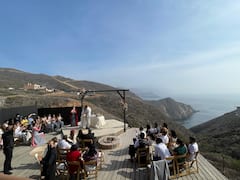There is more to Mexico than tacos and tequila. Often mistaken as part of South America, Mexico is in North America with the US to its north; the Pacific Ocean on its west and south; the Caribbean Sea, Belize, and Guatemala to its southeast; and the Gulf of Mexico to its east. It owns some of the most beautiful beaches in the world complimenting its mountainous landscape. With a rich biodiversity you’ll find the rarest plants and animals in its islands and forests. It is also a bustling cosmopolitan where you have a wide selection of dining options offering a variety of cuisines from its North to South regions. Here, drinks like Tequila, Mezcal, and the least popular Pulque taste best. Wondering what to buy in Mexico while in town? Check out our list below!
1. Molinillo (wooden whisk)

The Molinillo is a wooden whisk used in preparing hot drinks like cacao, hot chocolate, champurrado (chocolate porridge), and atole (a hot beverage made of corn and masa). This traditional wooden tool is commonly used in countries like the Philippines and Latin America. It is used by dipping the wooden whisk into a pot with the drink. It is held between two hands that are rubbed together to create a rotating motion that makes the drink frothy. The typical molinillo has an intricate carving on the head of the wooden whisk which makes it quite an interesting keepsake to bring home from Mexico.
2. Huaraches (Mexican sandals)

Huaraches, translated in English as “sandals”, is Mexican footwear with a design that dates back from the Pre-Columbian times. It is made from strips of leather braided together by hand to create a uniquely designed pair of sandals that are surprisingly durable and comfortable to wear. The origins of the traditional sandals can be found in the farms of Yucatan, Guanajuato, Michoacan, and Jalisco. In the 1960s, the sandals became part of the hippie lifestyle. Today, this pair of sandals is seen all over America for creating a fashion statement. It goes well with casual clothing and beach wear.
3. Lucha Libre Masks

Lucha Libre or “freestyle wrestling” was declared in July 2019 as an impalpable Mexican cultural heritage. This wrestling style was introduced early in the 20th century with its unique fighting form using colorful masks. The wrestlers called “luchadores” use swift maneuvers and rapid holds including the famous “high-flying” moves. Wearing the mask has a huge importance because the loser has to remove his mask permanently and pay a high wager with it. Wrestling tag team style is rampant in the Lucha Libre games especially with the “trios” or three-member teams. The colorful masks the luchadores wear are so distinct that they have become a national symbol.
You might be interested in these Airbnbs!
4. Papel Picado

During religious celebrations like the Day of the Dead you’ll see buildings and streets decorated with Papel Picado or colorful tissue paper flags chiselled with lovely pictures and patterns. These lovely tissue flags are recognized as a form of Mexican folk art with the distinct designs they bear. Aside from adding a lively and festive mood to the event, the design is related to the celebration of Christmas, Day of the Dead, Independence Day, feast of a Patron Saint, and special events like birthdays. These lovely flags originated from San Salvador Huixcolotla of the Puebla State and were made from thin and colored silk paper called papel de China (China paper). Creating the cut outs on the flags is an elaborate process. The artisanal method of paper cutting is passed on to every generation and spread all over the world to where the immigrants would settle down.
5. Mexican Sombrero

The Sombrero is one of the famous cultural and national symbols of Mexico. This traditional wide brimmed hat with a pointed top is typically worn by the upper and middle-class citizens during celebration and by workers while out in the fields. Taken from the Spanish word “sombra” meaning “shadow" or “shade”, the sombrero provides ample shade and sun-protection to its wearer. These distinguished pointy and high crowned hats have extra-wide brims to protect the head, neck, and shoulders from the heat of the sun and other elements. Some variations of the hat have a "borboquejo” or chin strap to keep the larger hats in place.
6. Worm Salt
Sal de Gusano or Worm Salt is a traditional Mexican condiment mixed into salsas, cocktails, and the popular alcoholic drink Tequila. It has a savory and slightly smoky flavor coming from its main ingredient – worms! Eating bugs or worms is not uncommon in Mexico and Sal de Gusano is a specialty. The worms used in making the salt are harvested from the same Agave plant used in making the traditional alcoholic beverages. These worms feed on Agave’s sweet nectar, then are sautéed and folded into hot tortillas or it can be toasted then grounded together with dried chilli peppers and rock salt to create Worm Salt.
7. Mezcal

Mezcal is one of two famous traditional alcoholic beverages that is distinctly from Mexico. The production of these drinks is heavily protected by the Mexican government to maintain its high standard and quality. Though Mezcal and Tequila are both made from the same agave plant, strict laws forbid Mezcal producers from making Tequila and vice versa. The main ingredient of Mezcal is made from any of the 28 varieties of the Agave plant and aged in 3 ways (Anejo, Reposado, and Abacado) using the traditional method of roasting and smoking the Agave hearts in a stone pit. Another distinct feature of the Mezcal is the “worm” at the bottom of the bottle. Are you brave enough to drink the smoky and sweet Mezcal together with the worm?
8. Tequila

The notorious tequila is a party favorite for its strong taste and potent effect. Mexico’s popular alcoholic drink is made solely from the blue Agave plant. The heart of the plant is baked in an oven built above the ground using a 19th-century distilling technique. The distilled beverage is produced in Tequila, a city in Guadalajara and in Jalisco state, the central western side of the Mexican state. The proper way to drink Tequila is to take it neat and straight up after licking some salt on your hands to tone down the burning sensation in your throat after you drink. You then suck on a slice of lime or lemon to enhance its flavor.
9. Mayan Wooden Mask

The Mayan Wooden Masks are more than just fancy handcrafted items you can use to embellish your home. They represent the history and culture of the Mayan people making it a great collector’s item. The masks have several uses and the intricate carved designs indicat its importance. The masks were used during war and in cultural and religious dances and portrayed ancient gods, the devil, important individuals, and jungle animals. These masks are the best representation of Mexico’s indigenous people, culture, and national pride. These are made from a variety of tropical wood and the hand-carving technique dates back to 2000 years ago. The price of the masks depends on the quality and difficulty of its creation.
10. Mexican vanilla

Mexicans claim that their version of Vanilla is the best if not better. Mexican vanilla is created from 10% alcohol, less than 1% vanillin, and Tonka bean extract. The extract exudes the same aroma and flavor as real vanilla. Vanillin gives its rich, smooth taste and enhances its flavor. It also contains the controversial ingredient Coumarin. Though it adds a sweet, buttery taste to artificial vanilla, it was found by FDA to be causing lung and liver cancer in mice. The ingredient was banned in the US but not in Mexico where it is still used in concocting the famous Mexican vanilla.
Treasures of Mexico
Buy any of the items listed above to be used as a gift or as a souvenir of your trip, or to decorate your home for the best way to pay tribute to Mexico’s fascinating culture. The various colors, tastes, and styles of these items reflect the vibrant history and lifestyle of Mexicans. Take one of these treasures home with you when you visit Mexico so you will have a lasting keepsake of their rich heritage.
History
Get Trip101 in your inbox
Unsubscribe in one click. See our Privacy Policy for more information on how we use your data





















Create an account to